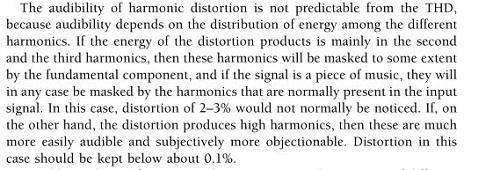What you are willing to admit to is meaningless, logically and scientifically speaking. It is based on the fallacy that people can possibly always know what all of their biaess are.Those individuals may exist but they are not human!

Actually it is simply a statement of my "assumptions" - which is not saying that it "proves" anything. I believe that any difference that can be heard can be measured (which is not to say that we necessarily are measuring the right things to detect them). However, if someone claims to hear a difference, but cannot produce any measurements that show a difference, then I consider their claim to be less likely to have merit than if they claim to hear a difference, and we also know that measurable differences do exist, so the only question is whether the differences (which we already do know exist) are audible. My (personal) "screening process" considers that claims of audible differences that are associated with documented measured differences are much more likely to be true that those in which there is no measured difference associated with the claim.
It's the same as my saying that I would be more likely to believe someone who said they saw a horse in their front yard than someone who said they saw a unicorn in their front yard - because we all know that at least horses do in fact exist (and can reasonably wander into front yards). Therefore, while both are in fact not technically impossible, I might get out my camera and go for a drive to perchance get a few shots of the horse, but I probably wouldn't bother to make the trip on the very-off-chance of getting a picture of a unicorn. (I could be wrong in either case, but, statistically, I'm a lot less likely to be wasting my time if I follow up on "horse stories" and ignore "unicorn tales".)
As for biases - I disagree with you there. I agree that we, as individuals, do a relatively poor job of accurately gauging or observing our own biases directly. However, lots of studies have been done about individual biases held by certain individuals and groups, and on how biases are formed, and on how biases affect our "perception". Therefore, I do have a pretty good idea what biases I (and you) are
likely to have - based on generalizations about human nature. For example, since we've been "taking opposite sides" on a certain discussion, we are both probably biased to find evidence that supports our point of view "more believable", and evidence that opposes it "somewhat less credible". Another common and well-known bias is that most Americans have a bias towards assuming that more expensive products are in fact better ("you get what you pay for"), so, all else being equal, they tend to be biased towards believing that "expensive wine tastes better" and "expensive equipment sounds better"; while, in many other cultures, this bias is not as prevalent. Studies have been done; it almost always works that way; and I have no reason to suspect that either of us is immune to it.
Now, speaking for myself, it has been my experience that differences which are claimed to be audible, but have no "numbers" whatsoever to suggest that a difference exists, have consistently turned out to be untrue, and that, when measurable differences do exists, they at least sometimes do turn out to be audible - which does in fact bias me towards being willing to spend effort whenever there seem to be numbers that "might reasonably seem to account for" a claimed audible difference - or, if I'm feeling especially lazy, "to give them the benefit of the doubt. (I think it's only fair for anyone who is trying to decide how much value to place on my opinion to understand that bias... especially since, as far as I know, that is not necessarily a bias that is common to the vast majority of humans.)






